| T O P I C R E V I E W |
| ullix |
Posted - 08/19/2020 : 07:11:27
There is an elaborate post on the topic of light-sensitivity of the M4011 tubes done almost 3 years ago: http://www.gqelectronicsllc.com/forum/topic.asp?TOPIC_ID=4540
But the effect is back! And it brings a new surprise.
Back then the M4011 tubes were made of clear glass. As a consequence, GQ modified the tubes by covering them with a black, plastic-like cover. Presumably assuming that the black cover would absorb all light before entering the tube, and therefore the light cannot make problems in the inside of the tube, creating spurious counts.
Sounds reasonable and it seemed to have worked. However, cause and effect is anything but clear, since I have also seen clear glass tubes, which did not exhibit any light-sensitivity whatsoever.
But, surprise, surprise, my tube tested now is one of those blackened tubes, and it does show a pronounced light sensitivity!
My conclusion is that some unknown - at least unknown to us - detail in the manufacturing is causing the problem, and it is just coincidentally related to the blackening. It is a fact now that some of the M4011 tubes are light sensitive, be they clear glass or blackened glass!
So, here are the data as graph, explained below. Anything which rises from the True Background scatter is made by light; needless to say but for completeness: nothing radioactive is anywhere near the tube:
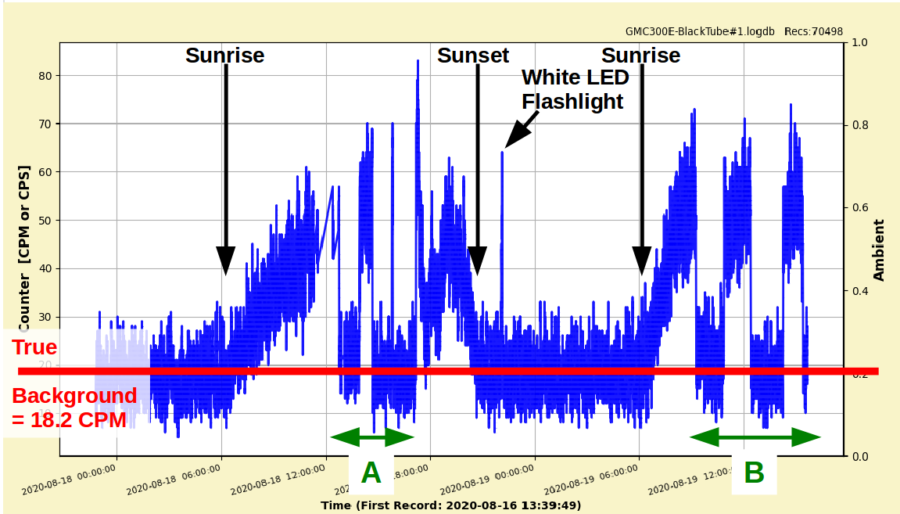
I played with my GMC300E+ counter during preparation for my GeigerLog 1.0 release, and wondered about its high background readings of 50 CPM and more, while I was expecting something under 20 CPM. The counter lay face-down, with its backside removed. So tube and electronics were looking upwards. I measured the anode voltage (by 10MOhm DVM via 1 GigaOhm resistor) as about 380V. This is rather low - I left it unchanged - but concluded that a too-high voltage was not the cause for high readings.
Inadvertently I laid some paper copies over the counter, and then noticed a drop in counts. I removed the copies and saw the counts rise. I repeated a few times and always got the same effect, as shown in the part marked with a green A. Just to the right of the A phase, you can even tell the weather from the counter data, as it changed from bright sunshine to rain and clouds, dimming the sunlight to different degree, but quite noticeable!
During the night, pitch-black outside and in my study, I shone a white LED flashlight on the tube, and it also resulted in increased counts; see marking in the picture.
It still seemed doubtful to me that a blackened tube is light-sensitive, and I suspected that the culprit is actually some other part of the electronic. So, I constructed a cardboard sleeve for the black tube. This would keep only the tube covered, and everything else exposed. The "sleeve device" with tube is shown in the photos, and the counter results are shown in the phase Green B part. Barely readable: the tube is a black M4011 2017 one. Clearly, with the sleeve on, the counts are right into background level.
So, nope, it is not the electronics, it is the tube and nothing but the tube. The blackened tube!
There have recently been quite a few reports about unexpected high count rates. My advice: check for light sensitivity!
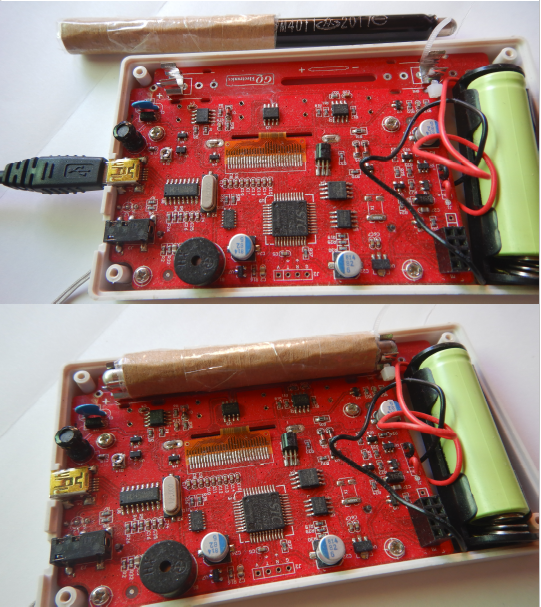
|
| 100 L A T E S T R E P L I E S (Newest First) |
| Damien68 |
Posted - 03/12/2021 : 01:13:39
if it affects more than 3 or 4% it is no longer marginal |
| cynoclast |
Posted - 03/12/2021 : 01:09:18
quote:
Originally posted by ullix

Welcome to "Groundhog Day in Light-Sensitivity County"! You may have missed this more recent topic on the matter: http://www.gqelectronicsllc.com/forum/topic.asp?TOPIC_ID=9544
In this topic EmfDev opinions that the tube is defect and suggests to email support and you will get a "good" tube.
So you did not open the case, but had kept the back cover on, just as EmfDev said is needed for proper operation. Hmm, does not seem to help.
To replace the tube you will have to remove the back cover anyway, so you can do it now. What type of tube do you have: M4011, J305, other, clear glass, blackened glass?
I now have a total of 6 tubes coming from GQ. Of those 3 are light sensitive. That is 50%!
What are the chances of me getting 50% "defective" tubes if that is an exception among thousands (?) of tubes? My guess, if more people check for light sensitivity, we'll get a lot more news on "defective" tubes.
I think the ? at the end broke your link but I found the thread anyway (REST developer FTW). I fixed it in my reply.
I did actually open the case at one point and tried to wipe down the tube - suspecting radioactive particles adhering to it - with a microfiber (lens cleaning) cloth to no avail. I don't have the back cover off at the moment, so I can't tell you the exact model, but the tube is clear glass. Although, from my reading that doesn't seem to matter as it seems some obscured tubes still react to light when they shouldn't.
Unfortunately(?) I ordered and received my unit through amazon so I don't have a GQ order number or anything, but I'll reach out to EmfDev or customer support soon.
Thank you so much for reply so quickly though! I wasn't expecting a response any time soon. |
| ullix |
Posted - 03/12/2021 : 00:46:47

Welcome to "Groundhog Day in Light-Sensitivity County"! You may have missed this more recent topic on the matter: http://www.gqelectronicsllc.com/forum/topic.asp?TOPIC_ID=9544?
In this topic EmfDev opinions that the tube is defect and suggests to email support and you will get a "good" tube.
So you did not open the case, but had kept the back cover on, just as EmfDev said is needed for proper operation. Hmm, does not seem to help.
To replace the tube you will have to remove the back cover anyway, so you can do it now. What type of tube do you have: M4011, J305, other, clear glass, blackened glass?
I now have a total of 6 tubes coming from GQ. Of those 3 are light sensitive. That is 50%!
What are the chances of me getting 50% "defective" tubes if that is an exception among thousands (?) of tubes? My guess, if more people check for light sensitivity, we'll get a lot more news on "defective" tubes.
|
| cynoclast |
Posted - 03/11/2021 : 22:34:05
I've been having some anomalous readings with my GMC-300E+ so I did some digging and found this thread.
Out of curiosity shined a very bright headlamp I own into the holes on the back right onto the tube and got this after just a minute or two: 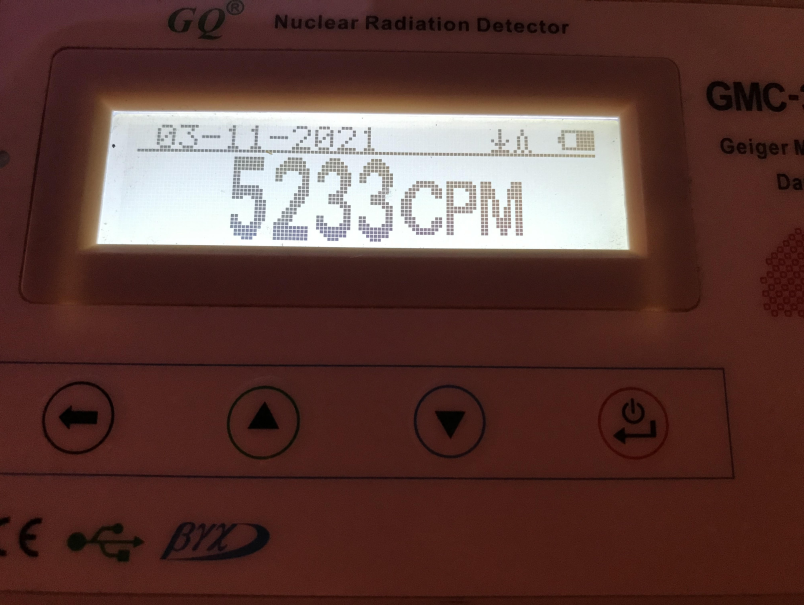
Light sensitivity (SER via LED) is for sure a thing with at least some of these.
Should I try and return the unit or get a new Mueller tube?
I'd like a Radiation detector that doesn't constantly false-alarm.
|
| Senketsu |
Posted - 02/04/2021 : 05:54:35
GQ GMC-300E Plus Re 4.50 is currently testing (newer firmware available?). The M4011 counter is not black painted, and yet it does not respond to the strong flash of a reporter's lamp applied to the holes at the bottom of the dosimeter
M4011 production 2019 y |
| Senketsu |
Posted - 02/03/2021 : 12:51:03
@Ullix Yes, they are most familiar to me.
Obsidian is hard to get, but I think it will also be available in the EU (currently available in the US and Russia)
Tomorrow I will pick up the GMC-300E Plus and also check the reaction of the M4011 to light (there will be no black coating).
I am currently writing a review of the GMC-500 model and additionally decided to discuss each option available in the menu (The most configurable dosimeter on the market)
|
| Damien68 |
Posted - 02/02/2021 : 00:53:45
I delete my previous post by error, sorry for that.
just to call back references:
Sensor is from "First Sensor compagny" is 100 mm2 PIN Photodiode + CsI:Tl scintillator
https://www.first-sensor.com/cms/upload/datasheets/X100-7_THD_3001447_3001448.pdf
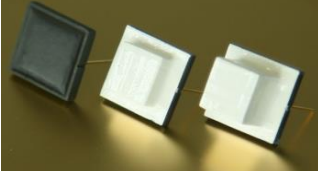
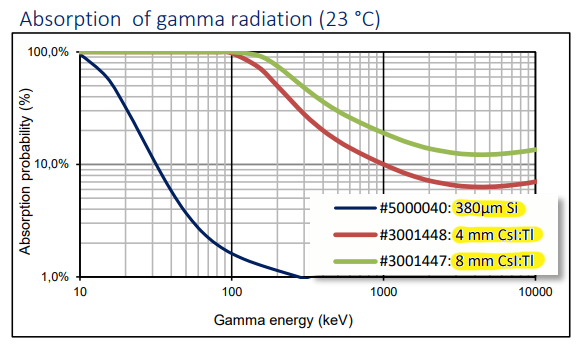
distributed by Mouser.
Interesting experimentations of Photodiodes and Scintillator with electronic detection stage basic explainations:
h**p://physicsopenlab.org/2018/07/08/si-pin-photodiode-plus-with-csa-sa/
h**p://physicsopenlab.org/2018/09/23/photodiode-and-csitl-scintillator-with-micod-csa-sa/ |
| EmfDev |
Posted - 02/01/2021 : 11:46:25
Hi Damien, thank you for sharing the sensor, I will let our team know and see if we can use it :) |
| Damien68 |
Posted - 02/01/2021 : 00:27:20
quote:
Originally posted by ullix
The Obsidian seems to be unavailable in the EU. Apparently the detection is based on scintillation. They are remarkably quiet on their website re the technology. Do you know if it is Sodium-Iodide? Cesium-Iodide? Other?
scintillation with solid state photomultiplier, but the sensor size is really small for scintillation.
on youtube we find videos, some favorable others not. |
| ullix |
Posted - 01/31/2021 : 07:46:55
Note: a post of mine has disappeared. Wonder if it will resurface. So, I repeat:
quote:
Radex Obsidian makes a pretty good spectrum and works with BecqMoni :)
The Obsidian seems to be unavailable in the EU. Apparently the detection is based on scintillation. They are remarkably quiet on their website re the technology. Do you know if it is Sodium-Iodide? Cesium-Iodide? Other?
quote:
I need to test GeigerLog, it seems to be a great app! Will it work with my Gamma Scout too?
GeigerLog does support downloading from the Gamma-Scouts. But the "live" mode of the 'online' version is not yet supported; I simply had no access to a counter to test. If you have one of those, and are willing to support some testing, it could be implemented.
quote:
I have performed the test, my GMC-500 and 500+ (both are v2) do not respond with an increase in radiation indications, even to a strong flash flash.
Good for you!
|
| Senketsu |
Posted - 01/31/2021 : 04:45:28
The Smart Geiger is not bad, but it has many disadvantages and it also reacts to shock...
Radex Obsidian makes a pretty good spectrum and works with BecqMoni :)
I need to test GeigerLog, it seems to be a great app! Will it work with my Gamma Scout too?
I have performed the test, my GMC-500 and 500+ (both are v2) do not respond with an increase in radiation indications, even to a strong flash flash.
I have a Geiger STS-5/SBM-20 and STS-6 GM counter, I can connect them to a universal radiometer and also perform a light tightness test |
| ullix |
Posted - 01/31/2021 : 02:04:16
quote:
I can contact Soeks directly and ask.
That would be great!
quote:
Flash lamps generate an increase in indications in the Smart Geiger and Smart Geiger Pro semiconductor meters (I used to take photos of smart Geiger and I noticed that).
I am not surprised, I reviewed the Smart Geiger Pro here https://sourceforge.net/projects/geigerlog/files/Articles/GeigerLog-Review%20Smart%20Geiger%20Pro%20%28SGP-001%29-v.1.0.pdf/download
This device is basically a solar cell, meant to convert photons into electrical signals. In my device the insulation against light was a copper foil. If that isn't perfectly tight, you'd see light effects. However, my device did not show any response to light (perhaps a matter of intensity; your photo lights may be stronger?).
The enticing aspect of these devices is that the electric impulse is in principle proportional to the energy of gamma quanta and thus could serve as a spectrometer. Unfortunately, my trials failed completely.
|
| Senketsu |
Posted - 01/30/2021 : 13:27:01
No problem, I'll always be happy to help! I have a blog, youtube channel, instagram account :)
Unfortunately, I don't know where Soeks buys new Geiger tubes, but in my Ecovisor F4 it is completely new and recently produced, I can contact Soeks directly and ask.
Today I will use a UV flashlight and a powerful flash (as a photographer I have strong reportage lamps).
Flash lamps generate an increase in indications in the Smart Geiger and Smart Geiger Pro semiconductor meters (I used to take photos of smart Geiger and I noticed that). |
| ullix |
Posted - 01/30/2021 : 09:07:58
quote:
@ullix, Thank you, but this is only a small part, I currently have 68 dosimeters/radiometers, I plan to take a photo of the my full collection soon, but I am currently waiting for Mazur PRM-8000, PRM-7000 and RD1212-BT
Good Lord! I think many people would be interested in comparisons/observations with all these devices. I want to encourage you to write something up - even if only few devices are covered - and I would very much like to present a copy of this on my GeigerLog sourceforge site!
May I remind you of my question re manufacturer/supplier etc for the SBM-20-1 tube?
quote:
Will the LED torch light be suitable for testing? I shone the flashlight at the back in the hole where is M4011 tube (covered with something black) - it did not increase the CPM in 500/500+ and 600 (sbt-11 mica window).
It depends. There are tubes, even clear glass tubes of the M4011 type, which do not exhibit light sensitivity, no matter what one tries, and then we found a blackened M4011 tube, where you had to shine the light onto a specific spot, which turned out to be one where the layer of lacquer was a little bit damaged. There is no explanation for the fact that some clear glass tubes are sensitive to light and others not.
So far the white light of an LED flash light had been enough to demonstrate light sensitivity, but if you can use at least a blue light LED, and even better, a UV light LED/Flash Light, you have a better chance of finding something.
Blue light from any source using the incandescent principle or even using a halogen lamp, e.g. using a blue (glass) filter, will probably not be helpful.
|
| Senketsu |
Posted - 01/30/2021 : 05:08:36
@ullix, Thank you, but this is only a small part, I currently have 68 dosimeters/radiometers, I plan to take a photo of the my full collection soon, but I am currently waiting for Mazur PRM-8000, PRM-7000 and RD1212-BT
Saving measurement data from my collection: Mazur PRM-9000, Gamma Scout, RadiaScan 701A, DoseRae2, Radex Obsidian, Soeks Quantum
Communication with pc and recording of measurement data: Radex RD ONE, MiniTrace S-5...
I would have to check out the entire collection.
Will the LED torch light be suitable for testing? I shone the flashlight at the back in the hole where is M4011 tube (covered with something black) - it did not increase the CPM in 500/500+ and 600 (sbt-11 mica window).
|
| ullix |
Posted - 01/30/2021 : 01:14:55
quote:
SBM-20-1 are still produced,
@Senketsu: this is interesting news! can you give links to manufacturer, supplier, shops?
It would be a major surprise if steel-housed tubes were also light-sensitive!
Edit: I just realize your footer to the post. That is an impressive list! Does it mean that you have all of those counters?
If so, which of them have an output to allow logging from the counter, and which have internal memory to allow stand-alone data-collection?
|
| Senketsu |
Posted - 01/29/2021 : 19:06:23
SBM-20-1 are still produced, I have several dosimeters equipped with the new SBM-20-1 (they are very nice, not as tarnished as the old ones).
I will check on my GMC-500/500 + and 600 how they react to light |
| Damien68 |
Posted - 01/18/2021 : 09:12:28
quote:
Originally posted by ullix
The Russian SBM20 tubes (and similar ones) have a steel housing, so light should not be an issue. They can be fitted into the GMC housings, but it takes some mechanical and soldering work. Electrically they can be considered drop-in products. But to my knowledge, there is no production of new tubes; you only get old supply from cold-war times. Those are still OK but understandably not a good base for a manufacturer of new devices.
Quarta-Rad aka Radex still uses the SBM-20 even on these recent products but it's a Russian company.
it is sure that it is not easy to find low cost and reliable supplier.
|
| Damien68 |
Posted - 01/18/2021 : 08:37:51
quote:
Originally posted by WigglePig
The glass does not need to contain potassium to generate this effect, the metallised coating inside the tube is sufficient. The differences of behaviour of different tubes can be explained by differences in the fill gas composition, thickness and type of coating (if relevant) as well as any other differences. That a significant difference between the bahaviour of different parts of a tube which is identified as sensitive does indeed suggest that it is some indirect ionisation effect in these cases (the cathode connection being the most sensitive area suggests the cathode bonding lead is where the ionisation is occurring.
There is quite some discussion, as well as descriptions of operating mechanisms and patent details, on the subject of tubes being used as UV detectors and it is clear that the construction is generally very similar to GM tubes but just operating them in a different region of their characteristic curve(s).
possible,
It would be necessary to make more precise tests and to illuminate only certain areas.
I don't have any light sensitive tubes.
what is certain is that there are chemical elements in the sensitive tubes which disappear in the insensitive tubes.
but anyway for M4011 it's a mess, on ebay sellers specify that: "the tube can be sensitive to light".
not "sensitive" nor "non-sensitive" but "can be sensitive".
more or less like: buy me one to know if you are lucky, but you will have been warned        |
| WigglePig |
Posted - 01/18/2021 : 04:12:10
quote:
Originally posted by Damien68
quote:
Originally posted by WigglePig
So, in summary, I would not be surprised to see elevated counts from Sunlight, or from LED lights (either UV or white) but I would NOT expect to see such behaviour from a "normal" incandescent lamp, however bright it may be.
with ullix we looked for, see above on this post,
ionization would be initiated by a photoelectric phenomenon by light (sun, UV, led, ...) on components of the glass of the GM tube by releasing an electron.
some tube glass would contain potassium others not. which will explain why some tubes are sensitive and others not.
The glass does not need to contain potassium to generate this effect, the metallised coating inside the tube is sufficient. The differences of behaviour of different tubes can be explained by differences in the fill gas composition, thickness and type of coating (if relevant) as well as any other differences. That a significant difference between the bahaviour of different parts of a tube which is identified as sensitive does indeed suggest that it is some indirect ionisation effect in these cases (the cathode connection being the most sensitive area suggests the cathode bonding lead is where the ionisation is occurring.
There is quite some discussion, as well as descriptions of operating mechanisms and patent details, on the subject of tubes being used as UV detectors and it is clear that the construction is generally very similar to GM tubes but just operating them in a different region of their characteristic curve(s). |
| Damien68 |
Posted - 01/18/2021 : 04:04:30
quote:
Originally posted by WigglePig
So, in summary, I would not be surprised to see elevated counts from Sunlight, or from LED lights (either UV or white) but I would NOT expect to see such behaviour from a "normal" incandescent lamp, however bright it may be.
with ullix we looked for, see above on this post,
ionization would be initiated by a photoelectric phenomenon by light (sun, UV, led, ...) on components of the glass of the GM tube by releasing an electron.
some tube glass would contain potassium others not. which will explain why some tubes are sensitive and others not. |
| WigglePig |
Posted - 01/18/2021 : 03:39:49
Now, this topic has greatly interested me for a number of reasons, chiefly that systematic uncertainties can often cause all manner of problems with detection and measurement systems. Due to this interest I have spent much of the weekend studying the operation of GM tubes and how their design and materials, especially the fill gases, affect their behaviour; there is a considerable amount of relevant materials available all arounf the Web which are useful in this regard.
Incidentally I have also found, completely by accident, about the products and activities of a company which has a factory near to where I live and how they have been involved in the development of detector tubes of various type. That is an aside, however.
The general operation of GM tubes is rather interesting in regards to the issue of light sensitivity.
What I suspect is that there are multiple mechanisms in play in different situations and these are difficult to isolate with the equipment we have.
Firstly, the GM tube will trigger on *any* ionising event of sufficient energy which interacts with the tube. This can be (in the case of the M4011 tube and similar) beta, gamma or X-rays from a "traditional" source of said, but this can also be caused by UV light of sufficient energy; this can be by generating emissions in the conductive outer of the tube coating or by direct interaction with the fill gas. This is precisely how the avalanche effect inside the tube which leads to a detectable pulse occurs; generation of UV photons which go on to ionise further gas in the tube.
Secondly, some sources of (especially) UV light generate ionising events within their junctions, sometimes by direct emission but also by UV ionisation in other materials. In fact, a white light LED actually generates UV and this UV then causes the white phosphor mixture to fluoresce. The UV action can cause emission of beta particles from the LED itself but can also exit from the luminere and cause ionisation in and around the GM tube in turn.
These observations have been arrived at by examining the descriptions and results of various tests done by a number of persons around the World, including persons on this forum.
So, in summary, I would not be surprised to see elevated counts from Sunlight, or from LED lights (either UV or white) but I would NOT expect to see such behaviour from a "normal" incandescent lamp, however bright it may be. |
| ullix |
Posted - 01/18/2021 : 02:21:01
@GreenPhlash: Thanks for posting your observation. Perhaps there are more people realizing that their devices have a light sensitivity problem.
The puzzling thing is that not all tubes, not even clear glass tubes, are light sensitive. I have some, which, to the best of my abilities, I have shown that they are not. And then there are tubes which are, despite having a black coating, as discussed in this present topic.
The problem is not to explain the physical base for light sensitivity. The problem is to explain why this does NOT apply to some tubes. And this is the question which makes it attractive to a physicist ;-)
Re alternative tubes: GQ seems to have moved away from using the M4011 - be it clear glass or blackened - towards tubes from the Jxyz type. Some of those tubes are mechanical and electrical drop-ins. When you have very low cost devices, you are likely to find those tubes, see e.g. my article https://sourceforge.net/projects/geigerlog/files/Articles/GeigerLog-Radiation-v1.1%28CAJOE%29-Support-v1.0.pdf/download
No announcement by GQ, so we can speculate that the move is done just because they are cheaper, not because of technical superiority. As long as the cause for the light sensitivity is not understood there is little hope that just another manufacturer makes a difference.
The Russian SBM20 tubes (and similar ones) have a steel housing, so light should not be an issue. They can be fitted into the GMC housings, but it takes some mechanical and soldering work. Electrically they can be considered drop-in products. But to my knowledge, there is no production of new tubes; you only get old supply from cold-war times. Those are still OK but understandably not a good base for a manufacturer of new devices.
I have used the SBM20 but only with external wiring, like shown here: http://www.gqelectronicsllc.com/forum/topic.asp?TOPIC_ID=4571
|
| GreenPhlash |
Posted - 01/17/2021 : 13:47:19
quote:
Originally posted by ullix
There is an elaborate post on the topic of light-sensitivity of the M4011 tubes done almost 3 years ago: http://www.gqelectronicsllc.com/forum/topic.asp?TOPIC_ID=4540
But the effect is back! And it brings a new surprise.
Back then the M4011 tubes were made of clear glass. As a consequence, GQ modified the tubes by covering them with a black, plastic-like cover. Presumably assuming that the black cover would absorb all light .....
I had been noticing that my 320 Plus with a clear glass M4011 tube over the last 5 months or so was getting higher background radiation readings. I played around with it, aimed the back of the unit towards the sun and saw readings jump to over 2000. After reading through this post [Thanks ullix !!] I tried to first paint the tube with black acrylic paint, but that stopped all readings, so I removed the paint, put on black electrical tape over the tube and now my readings are back to once they used to be. Odd. Do the other tubes that GQ sells fit into the 320? |
| Damien68 |
Posted - 12/16/2020 : 22:50:58
quote:
Originally posted by 37TS
I bought a 10 watts UV torch with a diode that has an UV-C pass filter on it (365 nm) and it blasts the counter with 12 uSv/h at 2000 CPM, per second!!!
I also have an halogen lamp, 250 watts, super hot, you cannot even watch it directly, yet the counter barely touches 14 CPM at 0.08 uSv/h with it.
How come?
the 365nm photons of UV light have a sufficient level of energy to detach an electron from the potassium atoms present in the glass of some GM tube, this by a Photoelectric effect.
it is a quantum effect, what is primordial is not the overall energy of light beam but the energy transported by each photons (so function of the light wavelength), and only photons with an energy level higher than a characteristic value named 'Work_function' will be able to extract an electron from potassium.
halogen lamps radiate more in the infrared and visible light and very little in UV, so the biggest part of photons emitted by the halogen lamp do not have the energy level required to detach an electron from potassium atome by photoelectric effect.
https://en.wikipedia.org/wiki/Work_function.
it is true that we could speak about beta radiation but in this case it is emerging on the tube caused by photoelectric effects, in this experimental conditions beta radiation doesn't come intrinsically from the light source. |
| 37TS |
Posted - 12/15/2020 : 16:25:30
New here but with some background.
Maybe I didn't read everything properly but it seems that no one mentioned the stimulated emission of highly ionizing radiation.
It's a common phenomenon and even led lights are subjected to it.
Electrons, after all, are considered radiation too and they get emitted by most filaments/compounds/semiconductors (among other types other ionizing radiations) when stimulated with electricity at varying conditions of temperature and pressure.
I own a GMC-300E V4. I did not tear it down yet but I can clearly see that it has a clear, transparent tube inside.
I bought a 10 watts UV torch with a diode that has an UV-C pass filter on it (365 nm) and it blasts the counter with 12 uSv/h at 2000 CPM, per second!!!
I also have an halogen lamp, 250 watts, super hot, you cannot even watch it directly, yet the counter barely touches 14 CPM at 0.08 uSv/h with it.
How come?
Basically, you really are detecting beta emission from those flashlights/sources (even the sun).
Read more about the stimulated emission of x-rays to know more about the physics behind the phenomenon, there's a lot to learn on the subject.
That's my take on it. |
| Damien68 |
Posted - 11/30/2020 : 11:08:13
sure that EMP can induce parasitic peak current in proportion of the area of the loop formed by two wires and this can result in a surge voltage.
but in normal environement the energies involved are very low and do not constitute particular risks for this kind of devices which in any case are already protected against surges (especialy in relation with electrostatic discharges wich constitutes a real risk du to his higher energy level).
to undertand this you can take a look around Biot-Savart law
Mean Time Between Failures (MTBF) of a device depends mostly on the components used in the device and also of how they are used. This can vary greatly also each device has its own MTBF which is only a statistical tool.
there can be a correlation between the MTBF of a device and the nature of its enclosure, but if it's the case, it's just a correlation and not a established cause to effect relationships.
for the automotive industry, there are particular standards because it's a strong and aggressive environment (a lot and strong overvoltages, EMI, electrostatic discharges, high di/dt ... ) so the components that can be used in this industry must meet specifics standards.
So for example automotive ignition control unit or automotive on-board computer are super shielded because in this case we should considere EMP (because of the harsh environment), but for GM counter on a desktop EMP can't affect his MTBF. |
| ullix |
Posted - 10/07/2020 : 01:44:03
@Damien: I disagree. You do not seem to understand the specifc situation.
I have demonstrated often enough, last time even in this thread (see my Reply#95) that you can use an AudioCounter with Linux and with Windows. I have written articles to demonstrate this, see https://sourceforge.net/projects/geigerlog/files/Articles/GeigerLog-AudioCounter-Support-v2.0.pdf/download and see https://sourceforge.net/projects/geigerlog/files/Articles/GeigerLog-Radiation-v1.1%28CAJOE%29-Support-v1.0.pdf/download .
You also do not seem to understand how interrupts would be treated; increment a counting variable upon an interrupt is a rather low-cost operation in terms of computing power. Handling the counts is also not an issue with today's breed of laptops and desktops, powerful enough to do this (as I have demonstrated). The issue comes up only when less powerful systems are running this same operating system.
You are also underestimating the pulse width. See this forum thread http://www.gqelectronicsllc.com/forum/topic.asp?TOPIC_ID=4598, e.g. Reply#10, where i determined the recovery length of a counter pulse are the GMC300E+ with the conclusion:
quote:
Relative to my assessment of the M4011 having a recovery time of 200us, the SBM20 will have 220us, and the SBT11A 250us.
This limits the countrates to CPS=5000, and given the Poisson distribution to something closer to 3000. Then on top of this we have the limit of the Hich-Voltage powersupply, which further limits the countrate, as the voltage simply is collapsing. Also well discussed in this forum.
Then the electronic of a counter will also shape the pulse width, and on a GMC300E+ the audiopulse width is 300 microsecond, adequate when the tube pulse length is 200 us! So here the limit is CPS=3300.
As I am now using a sampling rate of 44100/sec, and a sampling length of 32 samples, the max supported rate is CPS=1400.
All this is well beyond to what most people will experience, except for some who get medical treatment with radioactivity doses, which overwhelm the counters already. For everybody else, the doses to be experiences can be handled perfectly well even with AudioCounters.
|
| Damien68 |
Posted - 10/06/2020 : 00:33:33
I completely agree that neither windows nor linux are designed to be able to count pulses.
with an audio input, for example if we have 2 pulses of 100us separated by 10us , to be sure to sample the 2 pulses plus the space between these 2 pulses it would be necessary to sample every 10us (speed of 100 kHz) this is no realistic.
with a digital input (interuption) there is the interuption respond time which is not guaranteed, firing a script just to increment a register is not very ******y and ask certainly to end or save a context to run another one. we could make a driver in assembly language (machine code) or in c language, but that requires very precise skills but I know that's the kind of thing you can do with windows, certainly also on the raspi.
After that it will still work very correctly with a PC which will buffer the audio samples and will have the computing power to process the data offline, we may miss a few pulses because we will sample at 44.1ksample/s, but this will give a very marginal error. |
| ullix |
Posted - 10/04/2020 : 00:40:24
The use of GeigerLog on the 'Raspberry Pi' has been discussed in this thread. See e.g. my own tests in Reply #95. They show that GeigerLog works perfectly fine on Raspi when the counter, in my case a GMC300E+, is connected via the digital, USB-to-Serial connection.
It largely fails when GeigerLog is used in the AudioCounter mode, i.e. when the computer derives a Geiger count from inspecting the audio-clicks generated by the Geiger counter. (As the Raspi has nice audio-output, but no audio-input, you need a USB-Soundcard attached to the Raspi for this.) This is not really surprising given the computing effort needed, for which the Raspi seems to not have enough power.
As a remedy it was suggested to use the audio-click to trigger a hardware interrupt on the Raspi, using its GPIO pins. This would much reduce the required computing power.
This sounded intriguing, and I looked into that. There is actually the module 'RPi.GPIO' available for Raspi, which allows to monitor the GPIO pins for interrupts under control of Python!
However, there is a catch as stated very explicitly by the programmers of the module:
https://pypi.org/project/RPi.GPIO/
quote:
Note that this module is unsuitable for real-time or timing critical applications. This is because you can not predict when Python will be busy garbage collecting. It also runs under the Linux kernel which is not suitable for real time applications - it is multitasking O/S and another process may be given priority over the CPU, causing jitter in your program. If you are after true real-time performance and predictability, buy yourself an Arduino
Linux is not a Real-Time Operating System - and neither is Windows - so you cannot rule out that at certain times a bunch of interrupts occur, but the OS does not register them, as it is busy with other stuff. The result would be an under-estimate of the true count rate. It may not matter much on a powerful system - compare with the near-perfect Desktop results for the AudioCounter in Reply#95 where the Real-Time problems in principle are the same - but on a comparably low power Raspi the situation likely is different.
On an Arduino microprocessor, as mentioned in the quote, which is even less powerful than a Raspi, or on any of the microprocessors used by GQ in the GMC counters, you can exert a lot more control over the interrupts and can handle them up to a count rate higher than what even the fastest Geiger tubes can deliver.
I will not further pursue this, but if anyone takes a shot at it, I am curious about what limits you find!
|
| Damien68 |
Posted - 09/10/2020 : 23:52:51
quote:
Originally posted by Damien68
I don't know the raspi at all but there must be ways to handle IT with Python and increment register on it.
Seams to be not easy, discussion about that:
https://www.raspberrypi.org/forums/viewtopic.php?t=9207
EDIT: it would require as ullix says to write some dedicated functions to interface this by his application. what constitutes a full-fledged project, 100 microseconds latency is compatible with the 100 microseconds of tube dead-time.
perhaps the easiest is to buy a GMC-500 + 
if you have an arduino with a SAMD21 microcontroller, it is possible to count the pulses directly with a counter through an event bus line so without even fire ISR routines (zero CPU charge).
But after that you have to transfer the data and process it by the app and it still require some developpements. |
| Damien68 |
Posted - 09/10/2020 : 08:57:54
I don't know the raspi at all but there must be ways to handle IT with Python and increment register on it. |
| ullix |
Posted - 09/10/2020 : 01:20:22
In Reply#50 of this topic CCCComboBreaker raised the issue of connecting an Audio-click producing counter - like the Cajoe counter or any GMC counter - to a Raspberry Pi (Raspi). Since the Raspi has no Audio input, I suggested a USB sound card in combination with GeigerLog running on the Raspi.
I tested that and have to take back the Raspi & Audio part - that small computer is simply not powerful enough!
I bought this device https://www.amazon.de/gp/product/B07RS11PDD (8.18Euro) which has this chip: 'ID 1b3f:2008 Generalplus Technology Inc.' Works equally well on Raspi and on Desktop; just plug it in and select it as your audio device, no drivers needed.
Then I connected a GMC300E+ counter simultaneously both via its digital USB-to-Serial output and via its Audio output to the computer. The computer running GeigerLog was either the Raspi or my Desktop.
The summary of results is shown in this picture:
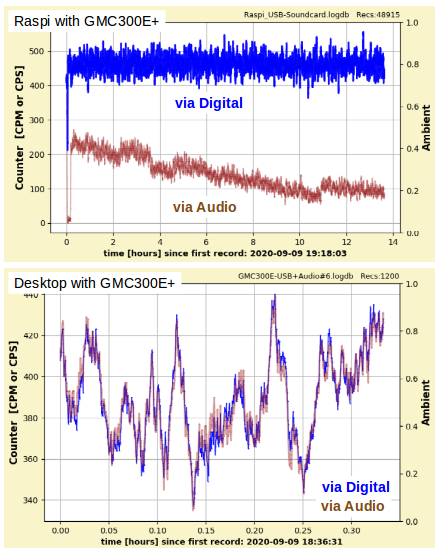
The upper one shows Raspi results: while Raspi easily handles GeigerLog with a digital connection to a GMC counter, it is simply overwhelmed with the audio processing.
The lower pic shows the very same setup, but now connected to my Desktop. One can barely see a load on the CPU. The data are identical within statistical scatter. The main reason for differences is that the time base is not and cannot be synchronized. In this particular example the overall average is Digital-CPM=388.48, while the Audio-CPM=388.45 ;-)) Typically the differences are about 1%.
Conclusion: Raspi is perfectly fine for Digital, but not useful for Audio!
On the Raspi you could use the Audio-clicks as external interrupts, and create a "driver" for Raspi, which counts these interrupts, and then provide some means for Python to get access to those counts - perhaps via a WLAN server running on Raspi -, then the computing burden for Raspi should be low and it very likely will work.
|
| Damien68 |
Posted - 09/07/2020 : 00:55:20
for the attenuation I'm talking about, it's not the ozone which will attenuate the 185nm UVC but the creation of this ozone.
but it's sure that shouldn't count on this attenuation to protect oneself. and it's concerns only the 185nm UVC and not the 253nm UVC
O2 + photon(185nm) -> 2O (break molecule)
O2 + O -> O3 (2 times) |
| Damien68 |
Posted - 09/07/2020 : 00:30:25
What I'm trying to say is just that the natural UVCs (those from the sun) won't get through the tube.
Then I also said that there will be an attenuation of the harshest UVC (185nm) that can come from a lamp since they create ozone, photon therefore was absorbed to split O2 molecule. But it is true that it is not necessarily a very strong attenuation.
Anyway with my 185nm lampe the M4011 tube has only a very moderate sensitivity, it is certainly the glass of its tube that protects it from this.
|
| ullix |
Posted - 09/07/2020 : 00:18:28
quote:
UVC are completely absorbed by the ozone layer and atmosphere
Are you trying to suggest that from the fact that solar UV-C is absorbed by a 10 km Ozone layer, followed a few 10km air, your UV-C light is absorbed from a lightpath of a few mm in the ozone free environment of your apartment and therefore cannot have an effect on a Geiger tube? Give it a try: put the lamp up and sit 1 meter away in front of it. With your theory nothing will happen to you. (NO, DON'T DO THIS! You would get very severe burns!)
Well, the addition of 1 GOhm sure looks like an afterthought, given the soldering job done. But it sure is a good move. It is sometimes called a banana strategy: the bananas ripen when in the hands of the customers. Read the GMC500+ review and just imagine how much GQ got out of this donation of 100 bucks! Perhaps it's time for another donation ;-)
|
| Damien68 |
Posted - 09/06/2020 : 08:25:15
@ullix:
on your post http://www.gqelectronicsllc.com/forum/topic.asp?TOPIC_ID=5369&whichpage=1
effectively you have a hardware revision 3.1 without hardware voltage reading. GQ must have catched your idea without warning you.  
 nor rewarding you either nor rewarding you either    
PS: This changes absolutely nothing to the normal operation of the device because there is no servo regulator using the voltage measurement to control the PWM output. |
| Damien68 |
Posted - 09/06/2020 : 00:40:55
After passing the 1 Gohms resistor and Rdivider and small capacitor (to remove signal noise), the signal is buffered by an operational amplifier (AOP), and go to an analog Input of microcontroller who measure the voltage with an Analog to digital converter.
I make some test and at least on my GMC-500+ hardware V5.2, soft v2.18 the indicated voltage is indeed that measured, in my case it's not an extrapolation of the setpoint. |
| Damien68 |
Posted - 09/06/2020 : 00:22:29
UVC are completely absorbed by the ozone layer and atmosphere
you can see wikipedia:
https://en.wikipedia.org/wiki/Ultraviolet#UVC
Moreover the ozone in Earth's stratosphere is continually regenerated by UVC sended by the sun following the process commonly called the Chapman cycle.
https://en.wikipedia.org/wiki/Ozone%E2%80%93oxygen_cycle
this is why on the surface of the earth and in daylight we cannot have UVC at least not in a significant amount.
Afterwards, in artificial light it is different but for the harshest UVCs they will still have a limited coverage because they will be absorbed to creat ozone or other. the coverage can be quite wide, but we are talking about artificial light and not the light filtered by the earth's atmosphere.
For the GMC-500+ at least in its latest revision, there is no potentiometer on the card, the voltage is adjusted by software adjustment (adjustment of the duty cycle of the PWM output driving the transistor of the HV generator)
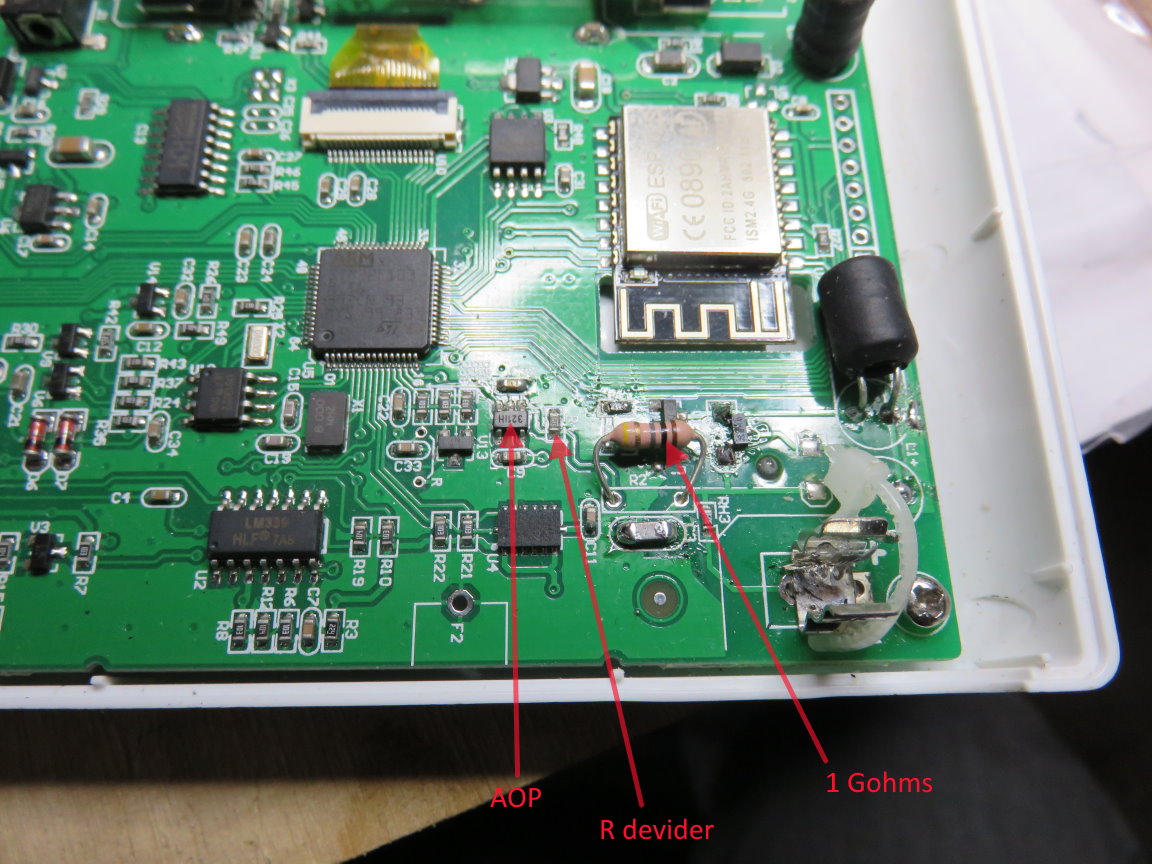
Sorry if you have an older version of the PCB.
R divider marking is 515 so is value is 5.1 Mohms which makes a voltage divider of 5.1 / 1005.1 = 1/197
And Tube1 voltage can be displayed:
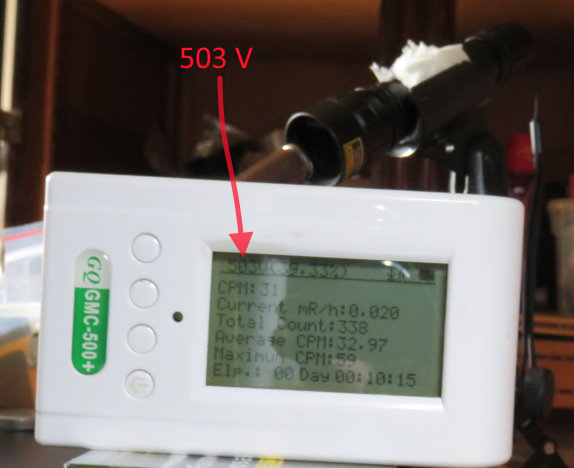
|
| ullix |
Posted - 09/05/2020 : 22:59:04
quote:
but anyway the UVC is absorbed by the air
No way! Why is UV-C light used for surface disinfection? Because it is basically NOT absorbed in the air and reaches the surface of benches, equipment, etc in a microbiologically clean environment.
quote:
on the GMC-500+ there is already a resistance of 1 Gohms to measure the voltage of the tube
That is the first time I hear this. What is the location of this resistor and what its Label on the circuit board (like R999)?
I believe the displayed value is derived by some formula from the position of the potentiometer used for setting the anode voltage. This may be more or less correct, but I doubt it is a true anode voltage measurement!
|
| Damien68 |
Posted - 09/05/2020 : 08:37:46
@ullix:
on the GMC-500+ there is already a resistance of 1 Gohms to measure the voltage of the tube and we can display it directly on the screen.
For me the measurement is reliable as long as the Lipo battery is not almost completely discharged. |
| Damien68 |
Posted - 09/05/2020 : 07:55:24
To conclude on the LND-712:
we can say that it is totally insensitive to daylight.
it is a little bit sensitive to UVC, and again it's just a quick test so it would have to be confirmed again, but anyway the UVC is absorbed by the air, and the sensitivity would only be really very minimal, we can therefore ignore this point entirely.
Be careful though that the glass valve at the back of the tube cannot be directly exposed to light.
The LND7317 seems to be made with the same materials than LND-712, so it would be surprising if they were sensitive to daylight. |
| Damien68 |
Posted - 09/05/2020 : 01:52:12
I make some test with LND-712, There are 2 points that I tested:
1: the mica window
2: the glass valve allowing the gas tube to be filled.
see photo bellow:
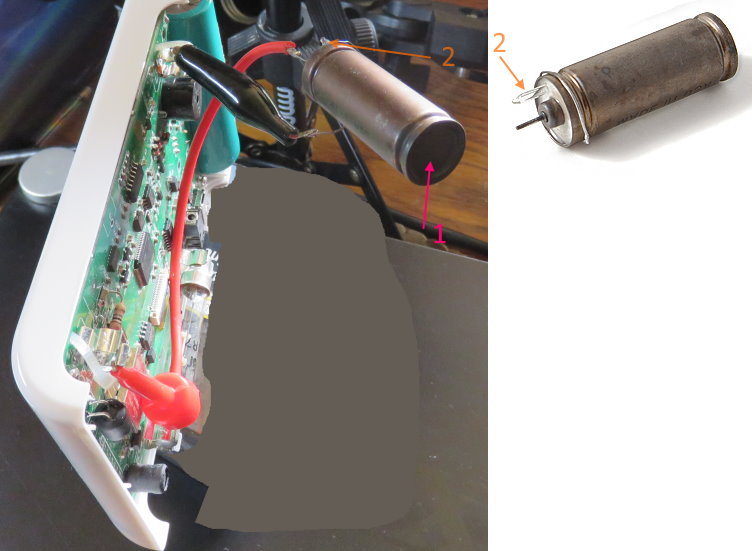
1. in front of the mica window:
- UVA 395 nm: no sensitivity
- UVA 365 nm: no sensitivity
- UVC: slight sensitivity (+30 CPM) at 1cm
2.in front of valve:
- UVA 365 nm: slight sensitivity
- others: not tested
Mica windows, 365nm test:
 |
| Damien68 |
Posted - 09/05/2020 : 01:00:44
I tested the M4011 with UVC light,
The tube is not insensitive, but not very sensitive either.
The light must remain blocked by the glass of the tube.
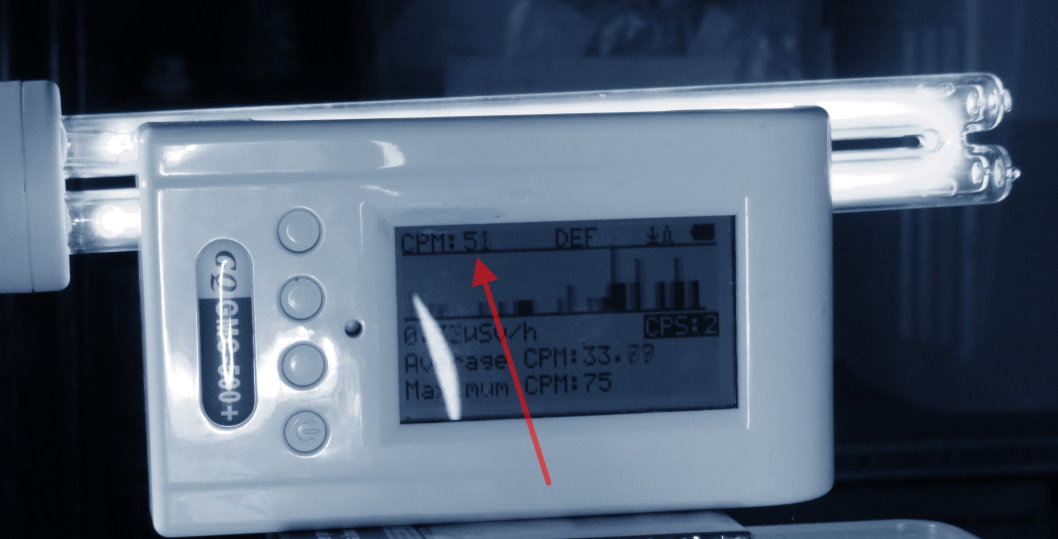 |
| Damien68 |
Posted - 09/04/2020 : 05:19:43
Neither me,I don't have no LND7317 nor SBM11.
I have a LND712 and I can test it later with 500v. it could be interesting. |
| the_mike |
Posted - 09/04/2020 : 03:50:05
I don't have the tubes nor the UV-lights aso...
(sadly, no means to get them atm...) |
| ullix |
Posted - 09/04/2020 : 00:17:12
quote:
Any chance you can test these models, too?
Sure, no problem. I'd suggest to use the Cajoe counter for experimenting - it is a whole lot cheaper than a GMC counter should you fry anything :-/.
You could connect it to GeigerLog for long-term recording, but even that is not necessary, because you could just listen to the audio clicks. If light does anything, you certainly will hear the increasing count rate!
The one hurdle to take - but that applies to any counter - is a decent way of measuring the anode voltage, because when using different tubes and conditions the voltage should be known! As a reminder: measuring the voltage isn't trivial; I am discussing the issue of a power source with very high internal resistance again in the Cajoe article https://sourceforge.net/projects/geigerlog/files/Articles/GeigerLog-Radiation-v1.1%28CAJOE%29-Support-v1.0.pdf/download and you can also look at the respective sticky here in the forum.
For any serious experimentation you'll need something like a 1 GigaOhm resistor (should be in the single digit $ per piece).
|
| the_mike |
Posted - 09/03/2020 : 10:21:08
Reading this thread and being completly fascinated about your findings, I just started to ask myself if the SBM-11 (pancake, used in one of the 600 series) or the US-tubes used in "better" models are lightsensitive, too...
Any chance you can test these models, too? |
| Damien68 |
Posted - 09/03/2020 : 06:47:33
I make some tests with SBM-20-1
is like SMB-20 without end cap, so it have in two extremity an exposed glass insulator.
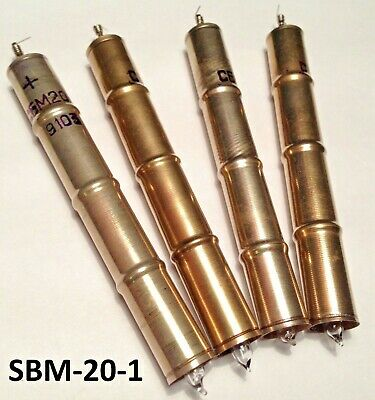
with 365nm Flashlight at 1cm of it extremity, it go up to 400CPM
with green lazer or 395nm flashlight, there is no reaction.
In fact the two tube SBM-20-1 and the M4011 (in it's non-light-sensitive version) behave the same comportement. the SBM20-1 is still radially protected but not on its axis.
|
| Damien68 |
Posted - 09/03/2020 : 05:09:18
So on my tube, its light sensitivity start between 365 and 395 nm.
following the Ullix table this can caused by :
1. Nd (Neodymium) usefull for magnets
2. Lu (Lutecium) is rare
3. It's a bit borderline but it could also be caused by Th (Thorium), thorium oxide is used to make camera's lens.
4. borderline too, can also be Y Yttrium can be use to do electrodes.
Anyway, no need to do tests with more shorted wavelenghts, unless if we want or to test the effectiveness of the black paint, but mine is compromised. |
| Damien68 |
Posted - 09/03/2020 : 04:49:08
Another test with Flashlight 395nm
absolutly no sensitivity.
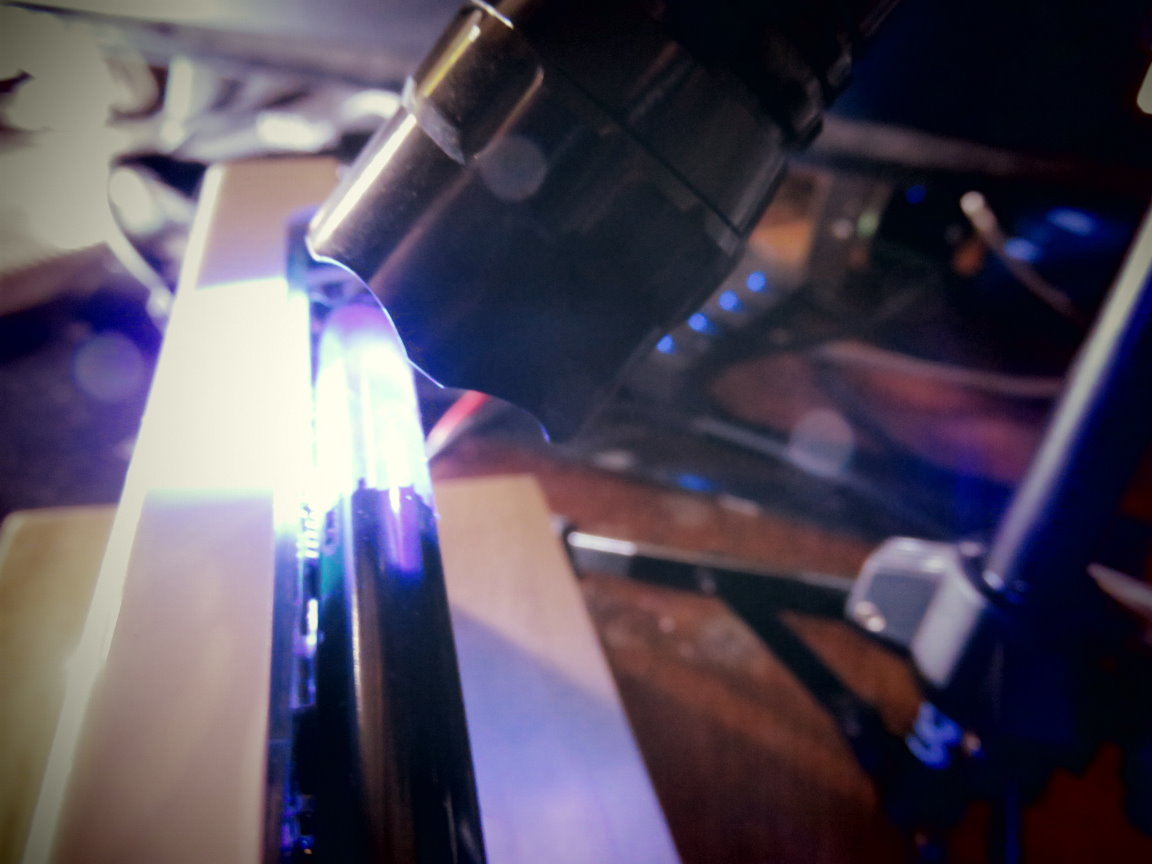
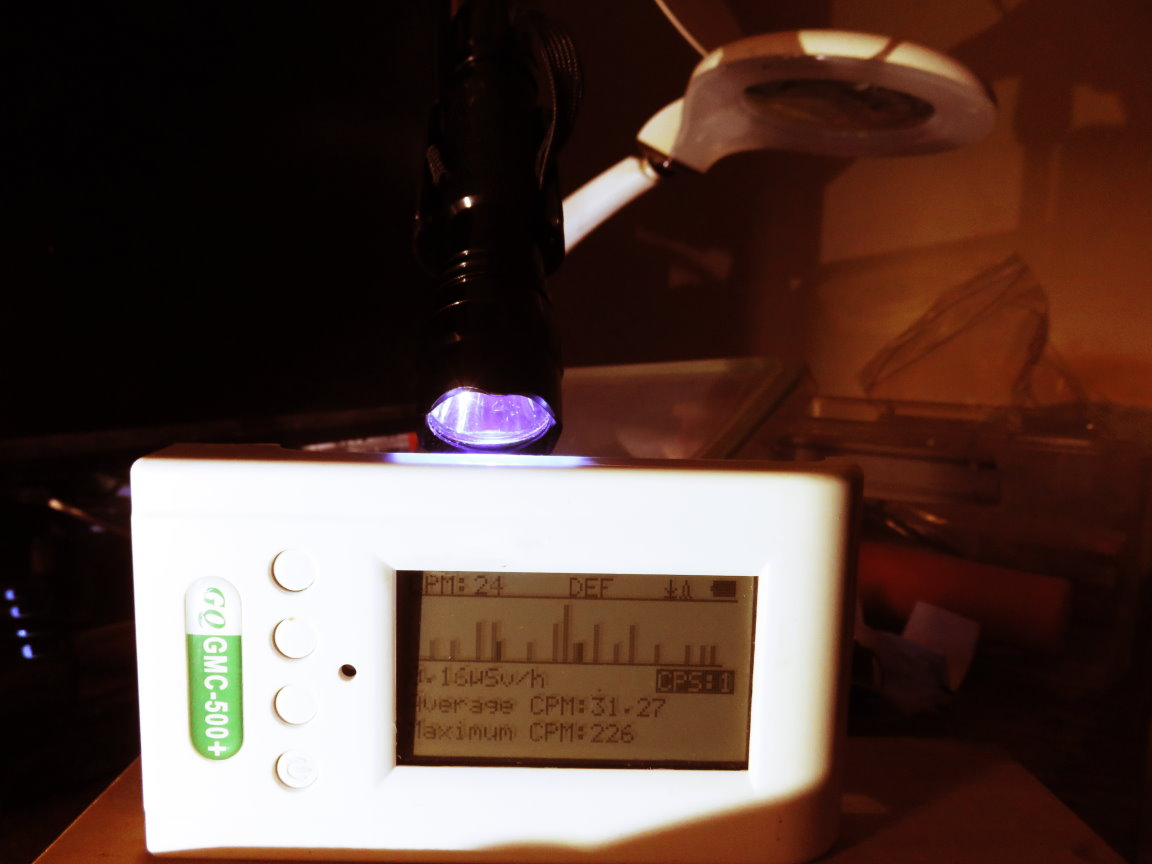 |
| Damien68 |
Posted - 09/03/2020 : 03:45:05
I do same test with green lazer, really no sensitivity, the count stays around 33 CPM at the exact background level, which I just checked again.

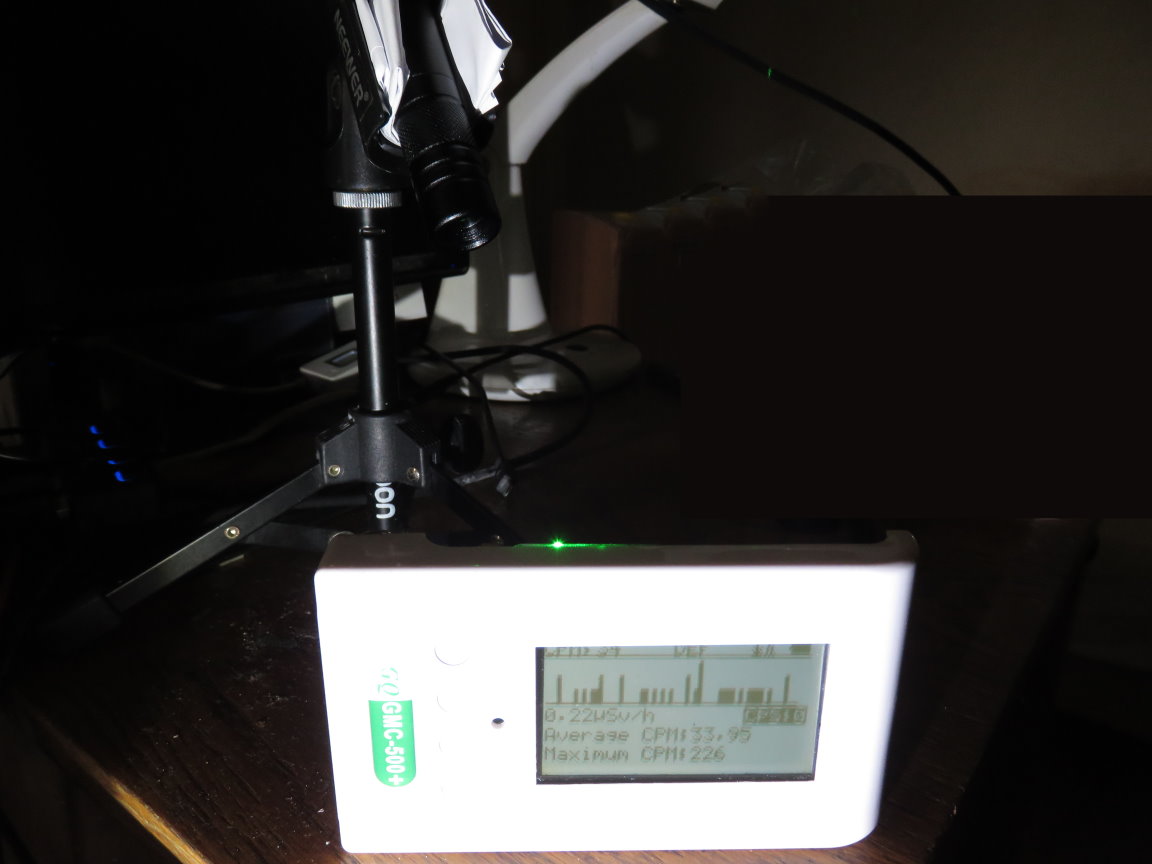
I do many tests with enlighting cathode pad and others, with no reactions |
| Damien68 |
Posted - 09/03/2020 : 02:59:30
Test with my non light sensitive M4011 'half' black tube and new 365nm flashlight:
this show 150 CPM (Background part: 33 CPM)

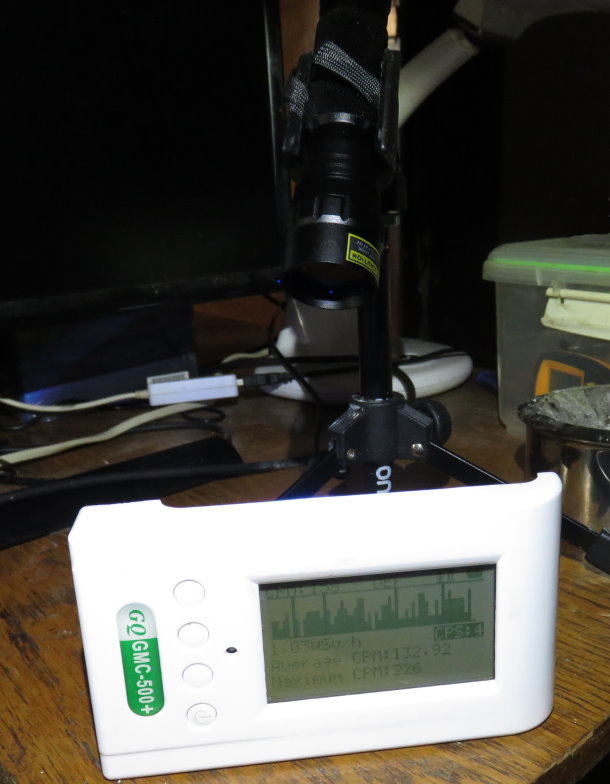 |
| Damien68 |
Posted - 09/02/2020 : 16:50:35
is not mine, I did not share it. |
| CCCComboBreaker |
Posted - 09/02/2020 : 11:29:32
quote:
Originally posted by Damien68
@CCCComboBreaker
If you are passionate about it and feel like it, you can also make your own application. Personally that's what I did on my PC / Windows because I'm a bit of a freak and I like having the buttons that I want, where I want and I like them to do what I want. And in the end it is not very complex. but there is still a lot to do.
For someone who wants to exercise, this is a good project. :-)
Is your project on github? |
| Damien68 |
Posted - 09/02/2020 : 06:51:39
Poor bebert (see reply 38) he shouldn't have bought his UVC lamp on amazon  |
| Damien68 |
Posted - 09/02/2020 : 05:25:07
what energy must be supplied to remove an electron from the tin?
certainly the energy of the one having the minimum one, but it's not necessarily a valence electron who are shared with other atom of its molecule. |
| Damien68 |
Posted - 09/02/2020 : 05:15:10
If we remove an electron from Tin oxyde molecule, What's going on?
exactly I don't know, it's the kind of thing that you have to study on a case-by-case, to know if the molecule breaks or not we must list all the possibilities, draw their energy diagrams to calculate overall energy of molecule for eachs possibilitys, and find the one that has the minimum one.
This is the general method used in chemistry to know if a reaction will take place or not.
But if M4011 works well, we can presume than Tin oxyde molecule does not break and the missing electron must simply be replaced by a new one from the power supply of the tube.
|
| Damien68 |
Posted - 09/02/2020 : 03:48:12
There are articles relating to the conduction of tin oxide:
https://ceramics.onlinelibrary.wiley.com/doi/abs/10.1111/j.1151-2916.1975.tb18974.x
https://aip.scitation.org/doi/10.1063/1.331675
it is also used in Lithium-ion batteries to constitute the anodes, with in addition oxidation / reduction reactions:
https://www.sciencedirect.com/topics/materials-science/tin-oxide |
| Damien68 |
Posted - 09/02/2020 : 02:41:36
I'm not going to cough, I'm going to do this outside, and use a drone to see what's going on and take pictures. :-) |
| Damien68 |
Posted - 09/02/2020 : 02:03:06
@ullix
yes all this is not really clear to me either, it is really a chemist's thing.
I found a article about:
https://en.wikipedia.org/wiki/Electron_configuration
effectively, to have diffraction in this kind of configuration, the thickness of the metalization must be around the same magnitude as the wavelength of the diffracted light, which causes an interference between two reflexions.
the two reflexions come from two interfaces.
the first interfaces is between the glass and the metalization layer, the second interface is between the metalization layer and the gas inside the glass.
each of this 3 material have different refractive indices, so we get two reflections that will interfer.
EDIT: Note: There is also a third interface which is the external surface of the tube (interface between the glass of the tube and the external air) but as the thickness of the glass is immense compared to the wavelengths of which we are interested, we will have no visible interference generated by this interface.
|
| Damien68 |
Posted - 09/02/2020 : 01:29:17
@CCCComboBreaker
If you are passionate about it and feel like it, you can also make your own application. Personally that's what I did on my PC / Windows because I'm a bit of a freak and I like having the buttons that I want, where I want and I like them to do what I want. And in the end it is not very complex. but there is still a lot to do.
For someone who wants to exercise, this is a good project. :-) |
| ullix |
Posted - 09/02/2020 : 00:57:20
A real datasheet on the M4011 tube could be really helpful. But whatever datasheet is out there is lousy, and that is already a glorifying description! There is never the manufacturing company mentioned, let alone a letterhead of the company being shown. Why this secrecy? The trustworthiness of the data is highly doubtful! And unfortunately, GQ never made any attempts to correct this. So whatever argument is based on such information needs to be taken with great caution!
One piece of such info is "Tin oxide Cathode". Tin oxides are at least SnO, SnO2, Sn2O3, which one is it? But oxides of metals tend to be insulators, how does that fit with the need for a cathode which has to be a conductor? And does it mean the manufacturing process starts with metallic tin, which is evaporated, and then oxidized (by letting air into the tube), or does it mean they start with the oxide, then heat it up, which does result in the decomposition into other forms of tin oxide plus its metallic form, which then may condense on the inner wall?
What actually is the substance on the inner wall of a M4011 tube? One usually sees rainbow colors at the tubes' wall, but there are reports of tubes, which show a grayish layer instead - as if oxidized and thereby destroyed - yet this tube still seems to work perfectly well in a Geiger counter?
We know the Photoelectric Work Functions of the elements. How do they change when we do not have the pure atoms, but molecules, like oxides?
A whole lot remains unknown.
My working assumption is that the rainbow colors result from a metallic tin deposit in the thickness of 300...600 nm, the wavelengths of visible light.
If so, then we should be able to kick out photo-electrons by irradiating the tubes with light of at least the wavelength equivalent to the work fucntion. Tin has a rather high work function of 4.42eV, equivalent to 280.5nm, which is UV-C. Perhaps the reason for choosing tin, as ambient sun or artificial light cannot activate its electrons?
I have updated the work function diagram to show tin and a few more light sources:
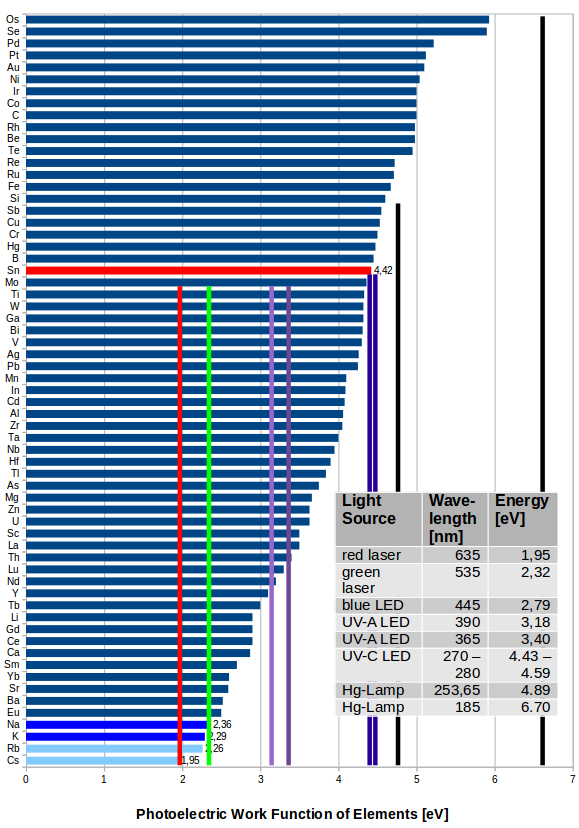
The 254nm line from a Hg-Lamp - Damien's darling - would certainly activate tin. (And of cause so would the 185nm line from an Hg-Lamp, but I would stay away from anything ozone producing. Why sit coughing at my desk and wondering about unexpected side effect? Ozone is chemically highly active and could do more damage than just killing bugs.)
Then there are UV-C LEDs. Unfortunately, there output wavelength are somewhere in the range of 270...280nm, which is again borderline for tin activation. Might work, might not.
If it works as expected, then illuminating a M4011 tube with that light should really result in a burst of "counts" in the counter.
|
| ullix |
Posted - 09/01/2020 : 23:43:08
@combo: sorry, I overlooked the missing audio input on a Raspi. Indeed, an "external sound card", aka an audio-to-USB converter might be the answer.
However, given GQ's description of their product I am not sure it is plain-vanilla enough for the job? Googling for "Plugable USB Audio Adapter" seems to give offers for Raspi at ~8#8364;, but I have never tested them.
Handling interrupts should be possible, but as I am currently preparing my 1.0 release of GeigerLog I will at this time make no attempts to further extend GL. |
| CCCComboBreaker |
Posted - 09/01/2020 : 22:57:54
*The forum autocorrected the two Euro Symbols to "AA" and does not let me edit my post... |
| CCCComboBreaker |
Posted - 09/01/2020 : 22:54:32
quote:
Originally posted by GBG12
The answer is a USB microphone. GQ sells one:
https://www.gqelectronicsllc.com/comersus/store/comersus_viewItem.asp?idProduct=4544 that works under Windows. Also many alternatives like Ugreen, etc. Some of these should unumerate under Raspian as an audio input device with the correct driver.
Thank you for your suggestion. However, I would have to buy another cable for €€ where the same result could be achieved with a simple jumper wire between the pins... |
| GBG12 |
Posted - 09/01/2020 : 20:23:56
The answer is a USB microphone. GQ sells one:
https://www.gqelectronicsllc.com/comersus/store/comersus_viewItem.asp?idProduct=4544 that works under Windows. Also many alternatives like Ugreen, etc. Some of these should unumerate under Raspian as an audio input device with the correct driver. |
| CCCComboBreaker |
Posted - 09/01/2020 : 10:43:35
@ullix please help me with this:
I want to use my Cajoe counter with a raspi. I have the first/original model B. I installed everything and seemingly it works. The old raspi seems powerful enough as the software starts up and is reactive. HOWEVER, only now I realized that there is no way of connecting the cajoe counter to the raspi! The raspi has an audio jack, but it is only output. It has USB ports too, but the cajoe unit does not output data via USB. Its USB cable is only a power supply.
It should be easy to solve this, because the cajoe unit transmits the clicks via a pin, too. I imagine you would have to connect the cajoe unit pin to a raspi hardware interrupt pin. Then in the geigerlog software, you would attach a (falling) interrupt to it; everything else should mostly be parallel to the other input approaches. BUT: This goes beyond my programming knowledge at this point. Is there any chance for you to consider implementing this in geigerlog? Or could you at least guide me in the right direction?
(Note to self: Cajoe output pin is 5v, raspi logic voltage is 3.3v, so maybe a resistor is needed in between? And cajoe and raspi grounds must be connected, I think.) |
| CCCComboBreaker |
Posted - 09/01/2020 : 10:04:07
quote:
Originally posted by ullix
Since you consider running a Raspi, I suggest trying GeigerLog. Once Python3 is installed, you can use GeigerLog also on a Raspi.
|
| Damien68 |
Posted - 09/01/2020 : 05:48:56
I found one lampe stock at amazon europe warehouse.
185nm + 265nm
185nm make ozone
https://www.amazon.fr/gp/product/B07XD1SHWF/ref=ox_sc_act_title_1?smid=A3J1QXSJKH0ADS&psc=1
if buy it, be very careful, read all the comments on the site about UVA and about Ozone too.
if the UV rays can pass through the glass of the M4011, that should make my GMC-500 go crazy with my half un-blacked tube |
| Damien68 |
Posted - 09/01/2020 : 03:26:25
Depending of the exposures, UVCs can be seriously dangerous,
I found the ISO 15858 standard describing its effects at low dose:
https://www.iso.org/obp/ui/#iso:std:iso:15858:ed-1:v1:en
So there are aparently specific standards for UVC devices.
I leave anyway the photo of Bebert (post #38) who was toasted with its UVC lamp  |
| Damien68 |
Posted - 09/01/2020 : 01:42:22
the tube is metalized inside with tin oxide, this is what diffracts the light.
it depends on how the tube is lit (incidence of light rays) and also on the angle with which you look at it. |
| CCCComboBreaker |
Posted - 09/01/2020 : 01:31:49
An observation: After powering the unit for a couple of hours, the inside of the tube walls seem to now have like a spectral color coating. It looks a bit like eloxed aluminium (?). Before, the glass was completely clear. Did you observe that too? What would explain this?
EDIT: ullix, I checked out your .pdf. Your geiger tube looks the same, see Fig. 2 with the Geiger tube in a plastic bag.
EDIT: After checking various pictures from the internet, I am not so sure anymore that the tube did not look like this from the beginning. Maybe I did not notice it initially and just did so now? |
| CCCComboBreaker |
Posted - 09/01/2020 : 01:23:39
@ullix:
Checked out your sourceforge. Leaves me in awe how much effort you put into this and how deep you went. Will try and get this up and running and post my plots later on.
EDIT: I am now reading your CAJOE unit .pdf and it's GREAT!!! |
| Damien68 |
Posted - 09/01/2020 : 00:10:36
may be
but sometimes you can sell products in devices and have restrictions for the spare parts alone which can be dangerous without the security around.
in fact I don't know, but if it legal in this form it's still dangerous, I don't want to advertise it without raising awareness.
In general, you still have to be careful about products imported directly from China or elsewhere, whether through Amazon or another trade site, if the product is regulated, if it is a counterfeit, if the invoce is under estimated or what, the importer is primarily responsible.
for UVC lamp, they are widely used in devices to sterilize, but they are provided with warnings, protections, screens, ....
like that on a socket, I don't know if it's legal or responsible.
|
| ullix |
Posted - 09/01/2020 : 00:00:06
@Damien: A thorough warning about the use of UV-C light is certainly justified, but there is absolutely nothing illegal about manufacturing and selling them. The best manufacturer in my view is Philips. https://www.lighting.philips.com/main/products/uv-disinfection
I used these tubes myself intensively in a microbiological lab to keep the cleanbenches free from any bacterial, fungal, and viral contamination. I sure works!
But I doubt if you can shift the emission between 185nm and 254nm by fiddling with the voltage. If you could, I am sure Philips has already done it and implemented it, because 185nm is undesirable, since it produces ozone. The glass of the ozone-free tubes is modified to block passage of 185nm, so only 254nm (and longer) gets through.
There is no legality issue. Just be aware of the danger this light has to all living matter, not just the bugs it is intended to kill!
By the way: I was shopping for UV-C LEDs. They exist but I found no source for small quantities. So far the offerings of all Chinese sources turned out to be fake, selling violet LEDs as UV-C LEDs. Anyone has a suggestion?
|
| ullix |
Posted - 08/31/2020 : 23:32:34
@CCCComboBreaker: Welcome!
As a Cajoe user you might be interested in my article GeigerLog-Radiation-v1.1(CAJOE)-Support-v1.0.pdf, which you find on my Sourceforge site under Files -> Articles: https://sourceforge.net/projects/geigerlog/.
This article also has the details on the P100:
quote:
P100 (Right, Top, WD-C3) connects the pulse signal to the audio connector. If you want to hear any clicks on your earphones, or want to connect the Cajoe-Counter to GeigerLog, then these two pins must be shorted, i.e. a jumper must be set!
and a whole lot more.
Since you describe yourself as a non-scientist, I'd again recommend my "Potty-Training" as a kind of starter for Geiger counter use: https://sourceforge.net/projects/geigerlog/files/Articles/GeigerLog-Potty%20Training%20for%20Your%20Geiger%20Counter-v1.0.pdf/download
The J-tubes are a broad offer of tubes, made from glass and also from metal: You find an overview here (scroll way down): https://german.alibaba.com/product-detail/geiger-tube-m4011-for-high-doses-of-radiation-detection-gieiger-muller-tube-60432321599.html
My guess is the J-company is different from the one making the M4011, but not certain. Info is hard to come by.
Since you consider running a Raspi, I suggest trying GeigerLog. Once Python3 is installed, you can use GeigerLog also on a Raspi.
To test for light sensitivity it is preferable to use LED light, as incandescent sources of sufficient intensity produce too much heat. A regular white LED (cold white better than warm white), but of course blue, violet, and UV-X LEDs are even better.
With your location in Germany, getting CPM=50 seems to be really on the high side! I'd expect something below 20 or not much above. The variation between tubes does not explain this observed magnitude. Check your setup, something seems wrong. Is the interrupt signal to the Arduino clean enough, or perhaps firing multiple times per click? Count the audio clicks manually with a stopwatch - still getting CPM=50?
|
| CCCComboBreaker |
Posted - 08/31/2020 : 12:52:48
quote:
Originally posted by Damien68
with GQ counters there is a Flash inside which allows all information to be recorded without having to use a computer, after you can download all to analyze them with a PC. this is one of GQ's best asset.
With the CAJOE meter there are no functions like this because no flash memory on the meter, well I do not know it too much but I think that we have no other choice than to leave the meter connected to a PC.
otherwise there are some M4011 tubes that are sensitive to light and others that are not (presumably due to potassium contamination). for the moment we cannot know which are and which are not.
but sensitivity starts with green light and continuous with stronger radiation (blue, violet, UV light ...) and the number of detections increases with the power of light.
for P100, I'm not sure at all, it's just a speculation, I just saw an image of the CAJOE PCB, but p100 could be the same signal as the audio jack signal for can be interfaced with an arduino for example .
I hooked up the CAJOE Geiger tube PCB to an Arduino. The number of ticks per minute is logged to the Arduino EEPROM. This solution is very basic, but anyway.
(A more sophisticated approach could be hooking up everything to a raspberry pi and gnuplotting the values there. A lamp could be plugged into a wlan or 433mhz power socket, and the raspberry would connect to the socket, with a cronjob turning it on and off. That's probably the safest/easiest solution for more "lab-like" measurements.) |
| CCCComboBreaker |
Posted - 08/31/2020 : 12:32:08
quote:
Originally posted by Damien68
J305 and M4011 are very close but J305 is 1.7cm more longer than M4011 but aparently same technology.
Will make sure to point out that I tested the J305, not the original M4011, when uploading measurements/plots later on. |
| CCCComboBreaker |
Posted - 08/31/2020 : 12:21:14
quote:
Originally posted by Damien68
letter should be betta gamma (in Greek) it's the radiation detected by the tube
Thanks, that's it! |
| Damien68 |
Posted - 08/31/2020 : 11:49:53
letter should be betta gamma (in Greek) it's the radiation detected by the tube |
| Damien68 |
Posted - 08/31/2020 : 11:47:23
J305 and M4011 are very close but J305 is 1.7cm more longer than M4011 but aparently same technology. |
| Damien68 |
Posted - 08/31/2020 : 11:40:14
with GQ counters there is a Flash inside which allows all information to be recorded without having to use a computer, after you can download all to analyze them with a PC. this is one of GQ's best asset.
With the CAJOE meter there are no functions like this because no flash memory on the meter, well I do not know it too much but I think that we have no other choice than to leave the meter connected to a PC.
otherwise there are some M4011 tubes that are sensitive to light and others that are not (presumably due to potassium contamination). for the moment we cannot know which are and which are not.
but sensitivity starts with green light and continuous with stronger radiation (blue, violet, UV light ...) and the number of detections increases with the power of light.
for P100, I'm not sure at all, it's just a speculation, I just saw an image of the CAJOE PCB, but p100 could be the same signal as the audio jack signal for can be interfaced with an arduino for example . |
| CCCComboBreaker |
Posted - 08/31/2020 : 11:31:55
By the way, while the tube on my unit looks exactly the same as your M4011s, mine has J305 printed on it, followed by two hard-to-read letters, probably "Br". I would post a picture, but the print faces the board and is barely readable. You can just barely read the shadow on the board.
I think M4011 and J305 are just different labels for the same design. With my J305, the cathode pin pierces the tube glass, too. |
| CCCComboBreaker |
Posted - 08/31/2020 : 11:14:04
On a sidenote, do you know by any chance what the two "P100" pins on the CAJOE board do? |
| CCCComboBreaker |
Posted - 08/31/2020 : 11:01:27
Ok, the first measurements I just took do not suggest light sensitivity. Will now measure over a couple of hours or so and report back. Please just give me some time to set up a solution where I do not have to leave my laptop running all the time, maybe storing the readings to the arduino EEPROM or an SD card instead of sending them to the laptop via serial.
I do not have a science background, I am from a very different field and merely an enthusiast. Did I get it right that the light from a bright desk lamp is sufficiently powerful to trigger the photoelectric effect, if the tube is potassium-contaminated? I also understand that the more light, the better if you want to deliberately induce the effect (as long as the light is above the reddish spectrum)?
|
| Damien68 |
Posted - 08/31/2020 : 09:59:59
Thanks! it's rewarding and it's nice. |
| CCCComboBreaker |
Posted - 08/31/2020 : 08:07:43
Registered here specifically to tell you that I am following your discussion and love it! Brilliant how you figured things out. Superb.
By the way, I too very recently bought the CAJOE Geiger unit. The tube is clear glass. The print on the tube says 2020II, which suggests it is a very recent version. I will test it and keep you updated. (Subjectively, it ticks closer to 50 times than to 25 here on my brightly-lit desk.) |
| Damien68 |
Posted - 08/31/2020 : 00:27:43
now we know why some black tubes are still sensitive to light,
remains the question why some transparent tubes are sensitive to light and others are not, certainly (with good confidence) because there would be potasium in the glass or elsewhere. if it, at the same time it must increase the background because of the K40 presence. by what order of magnitude? |
| Damien68 |
Posted - 08/30/2020 : 22:55:07
I may have just made a dumpling, the black in the tube seems to me now to be fluorescent UVA powder.
Fluorescent tubes (germicidal or not) are based on mercury (Hg) vapor. the emitted spectrum therefore corresponds to the energy gain that can be taken by a electron in a excited mercury atom after having been struck by a free electron. (atomic orbital ...)
it emits rays predominantly at wavelengths of 253.7 and 185 nanometers.
https://en.wikipedia.org/wiki/Fluorescent_lamp
The lamp I mentioned, I select it because it is the only one that Amazon has in stock in its warehouses in France and therefore imported by amazon, it is not necessarily by chance and it is surely the only who is not dangerous.
we find others like this next one at amazon but you have to import them from China, I don't know if it's legal, but if it isn't and if you buy it, it's you (the importer) who are in violation and exposed to a ticket, and to assume all the consequences:
                                         
                                                             
                                         
                                                             
                                                             
                                                             

                                         
                                                             
                                         
                                                             
                                                             
                                                             
Image of skull from: https://www.wish.com/product/5dbfc1474b60cc002822922d , https://www.wish.com/product/5d41164010b09f413c43831c and https://www.papado.fr/produit/sticker-tete-de-mort
we can certainly adjust the balance between the ray radiation (253.7 and 185 nanometers) by adjusting the energy of the free electrons (by changing the electric field between the two electrodes of the tube)
Well! it comes out of the subject and interests, I'm going to forget that. |
| ullix |
Posted - 08/30/2020 : 21:53:01
@Reply 32: good observation again. Using a strong magnifier I could now recognize the white-grey banana shaped mark just north of the tip of your arrow as the rest of the cathode wire. At its north it disappears into the glass. As far as I can tell it is still all covered with paint.
@Reply 34: I take it that the number of emojis is proportional to your awareness about the dangers of this light! But is it really 254nm light? What makes me wondering: the Amazon pictures show it rather leisurely placed in the kitchen and living room. However, @ 254nm you must ensure that no people are present who could look into that light or who could be exposing their skin to this harmful light! And it has a black glass color? That is strange too. I have seen such dark glass color only in the type of black party lights, which is not harmful. Staining quartz glass black is a possibility, but why do it?
But if it is 254nm then we have 4.88eV photons. Looking at the work functions in my Reply#31 these photons would kick out electrons from almost everything else; to name just those of greater technical relevance: Calcium, Zinc, Magnesium, Aluminum, Cadmium, Manganese, Lead, Silver, Tin, Mercury, Chromium, Copper, Silicon, Iron! It is probably impossible to manufacture anything without at least one of those. There should be a strong photo-effect of this light.
However, there may not be one. Assuming that the light needs to reach the interior of the tube (is that a necessary assumption?) it has to pass the glass wall of the M4011 tube.
Germicidal lamps, like your lamp supposedly is, emitting 254nm are regular fluorescent lamps except for two important differences: 1) there is no white coating in the inside which does the conversion of UV to white light, and 2) lamp glass is a special, more expensive quartz glass, which allows the passing of 254nm. Thankfully, regular glass absorbs all 254nm light.
The M4011 tube glass is surely not quartz glass, but is it thick enough to absorb all 254nm? If it is, we may not see any effect at all.
We also don't know if the black paint of the M4011 is still black for this 254nm UV light, or perhaps transparent?
Looking forward to see your results.
|
| Damien68 |
Posted - 08/30/2020 : 08:53:38
Einstein was German like you
... |
| Damien68 |
Posted - 08/30/2020 : 07:53:23
you must be right, I couldn't find a website in English but potassium carbonate (K2CO3) is widely used in glass manufacture, potassium can also be used as an additive in other forms. |
| Damien68 |
Posted - 08/30/2020 : 07:01:06
To experiment, I found a 254nm UVC lamp from amazon for 18€:
                     
     not hurt yourself with. not hurt yourself with.   
                     
                    

                    
                                   
   is 220v AC and ask to be very careful to is 220v AC and ask to be very careful to       not hurt yourself with. not hurt yourself with.   
   https://www.amazon.fr/Bonlux-D%C3%A9sinfection-St%C3%A9rilisation-Ultraviolette-Germicide/dp/B088W82TGY/ref=sr_1_16? https://www.amazon.fr/Bonlux-D%C3%A9sinfection-St%C3%A9rilisation-Ultraviolette-Germicide/dp/B088W82TGY/ref=sr_1_16?
                                   
another black tube  |
| Damien68 |
Posted - 08/30/2020 : 06:23:25
certainly it is baked paint. and there must have been a pocket of confined air inside the cap (between sealing and glass) which pressurizes (with the oven heat) and then forming the bubble.
there is a ventilation hole on the cap to allow soldering, but there may be another one non-communicating air pockets btween sealing and glass.
for welding, the ventilation hole is necessary, otherwise during cooling, the weld (still viscous) would excavate because of the depression in the cap cooling down and it would end up making a dry weld |
| Damien68 |
Posted - 08/30/2020 : 05:35:11
Great!
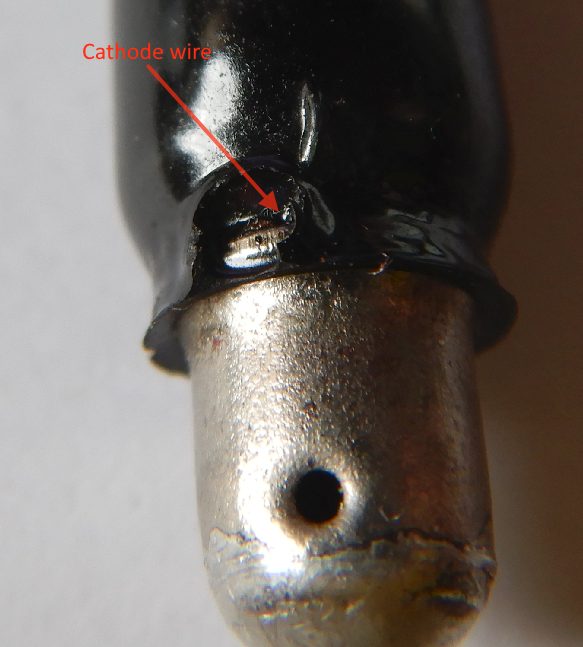
His base shape resembling as a round line of iso force/pressure topology, so when it was formed the paint was necessarily flexible and therefore not dry.
This explains, among other things, why aluminum roll has not changed anything.
In any case it raises a mystery
excellent diagram, the Chinese should have read it before making their tube :-)
|
| ullix |
Posted - 08/30/2020 : 03:55:04
In further investigating the black tube, I noticed that the strength of the light effect depends on the rotational position of the tube. Upon closer inspection of the tube I saw a bit of damage of the black paint at the cathode end.
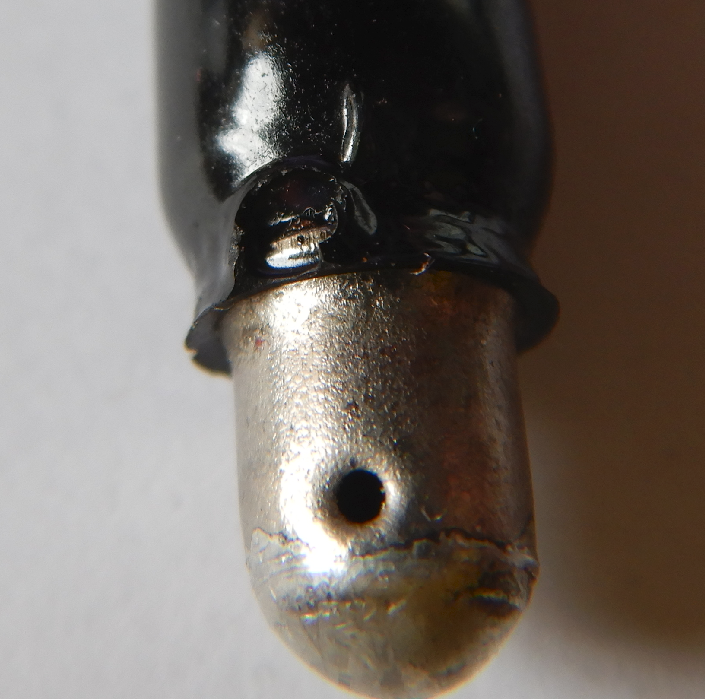
It looks like the paint had initially formed a bubble, which eventually had burst. I do not know whether this damage had been there since I received the tube two years ago, or happened at any later time. But this damage seems to be the only source for the light sensitivity. Directing a white flashlight onto it makes the counts take off like a rocket. Same effect when using UV light (365nm, 390nm). Looking for a more focused light spot to only cover the damaged spot, I used a green laser pointer. The counts also took off, but perhaps not quite as intense. Then I tried a red laser pointer, and all remained quiet. No counts whatsoever (except for the usual CPM=20 background).
A classic Photo-Electric-Effect! Too bad the Nobel prize is already taken ;-)
I searched for a list of activation energies for elements, called Photoelectric Work Functions. I found these sources in big physics text books down to Wikipedia: h**p://web.pdx.edu/~pmoeck/books/Tipler_Llewellyn.pdf https://public.wsu.edu/~pchemlab/documents/Work-functionvalues.pdf h**p://hyperphysics.phy-astr.gsu.edu/hbase/Tables/photoelec.html#c1 https://en.wikipedia.org/wiki/Work_function. The data are close, but not identical. I plotted them by energy, and added colored lines for the energies of my light sources.
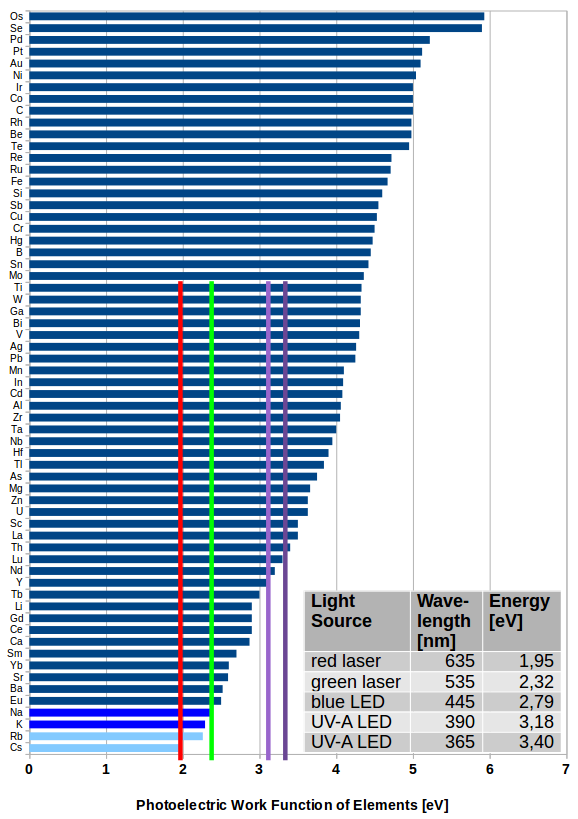
For the vast majority of chemical elements, even 365nm cannot kick out electrons. The red laser has an energy of 1.95eV, and the only thing it might activate is Cesium. Cs has a work function of 1.95eV in one source, but 2.1eV in another. So, while a red laser did not produce counts, it remains unclear whether it can't activate Cs, or Cs is not present.
A green laser can certainly activate Cs, Rubidium, Potassium. Sodium is another borderline case with a laser energy of 2.32eV, and a work function of 2.28eV in one, and 2.36eV in another source.
Of the elements activatable by 390 and 365nm most are rather unusual, with the exception of Calcium.
A firm conclusion cannot be drawn, but the candidates are identified: Cs, Rb, K, Na. If I had to place a bet, I would bet on my beloved Potassium!
And why only in some tubes but not in all? I guess there was indeed some sloppiness in manufacturing: impure metals used for the cathode wire, impure metals used for the cathode metallization, glass washing with a K containing detergent, K leakage from the glass upon melting, and perhaps more.
It does look like a manufacturing issues after all.
|
| Damien68 |
Posted - 08/28/2020 : 03:53:01
we can find UVB or UVC flashlight (200-300nm) just on china market, I think it must be quite dangerous.
UVB is mainly used for horticulture,UVC for disinfection.
But the yields of UV B and C LEDs are really very moderate (around 20mW of light emitted for more than 1W consumed).
just for curiosity, can find UVC Led sample here: https://eu.mouser.com/Optoelectronics/LED-Lighting/LED-Emitters/High-Power-LEDs-Single-Color/_/N-8usfn?Keyword=uvc&FS=True
200nm is 6.2 eV so 6.2v starts to do a lot for a diode junction
To resume:
UVA is: 400 to 315 nm <==> 3.1eV to 3.9eV
UVB is: 315 to 280 nm <==> 3.9eV to 4.4eV
UVC is: 280 to 100 nm <==> 4.4eV to 12.4eV
Other UV: 100 to 10 nm <==> 12.4eV to 123eV
X-Ray: 10nm to 10 pm <==> 123eV to 123keV
gamma: <10pm <==> >123keV
there is some relevant data about Philips UVC electroluminescent tube, it is better able to provide UVB or C:
https://www.assets.signify.com/is/content/PhilipsLighting/Assets/philips-lighting/global/20200504-philips-uv-purification-application-information.pdf
|
| Damien68 |
Posted - 08/28/2020 : 03:05:15
365 nm is UV-A not UV-B :) but is good.
https://www.who.int/uv/uv_and_health/en/
|
| Damien68 |
Posted - 08/27/2020 : 09:59:34
@ullix 365nm is nice, I have one that I buyed for coating inspection (coating with colorant) but is 395-410nm, juste the limit of UV :(
Why M4011 responds even to incandescent light? To find out, GQ could sign an NDA with the Chinese and ask them, but after they couldn't tell us, so once again that would be booby. |
|
|

